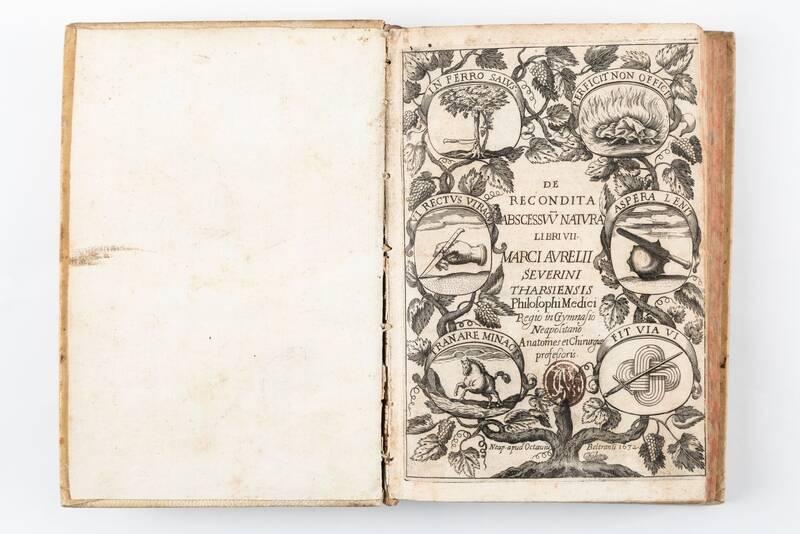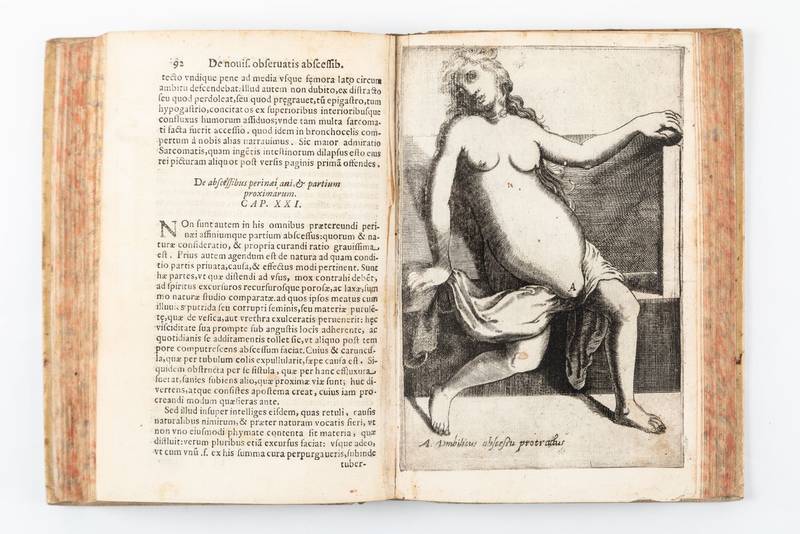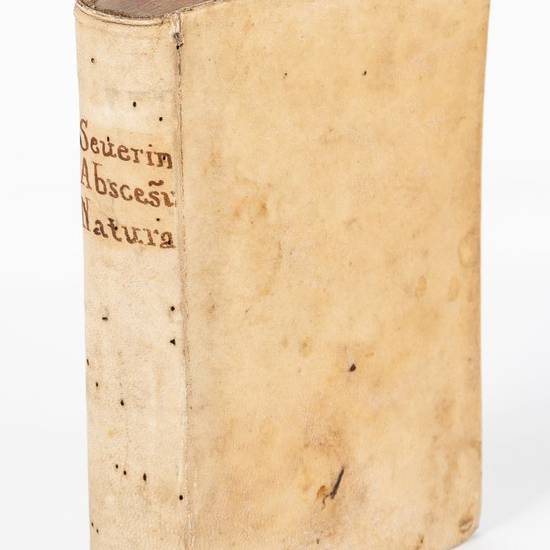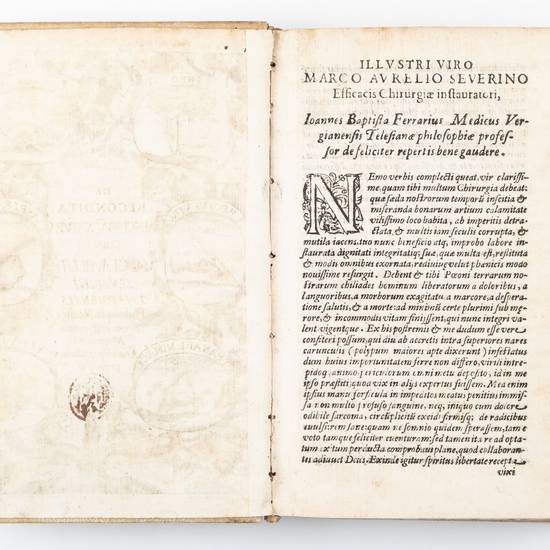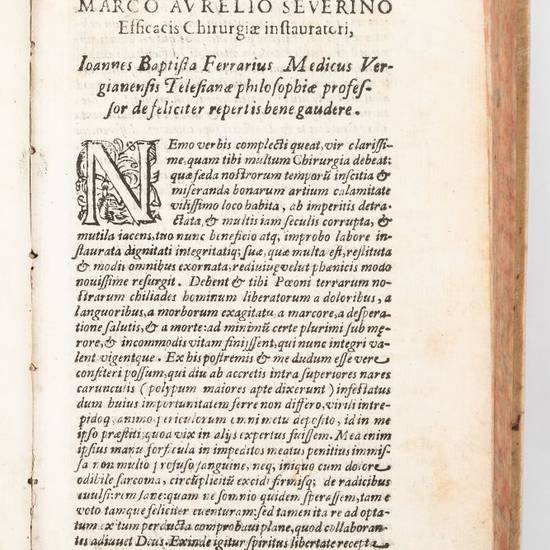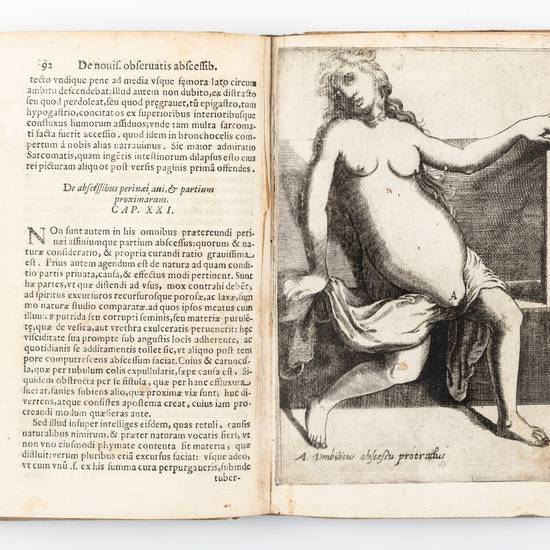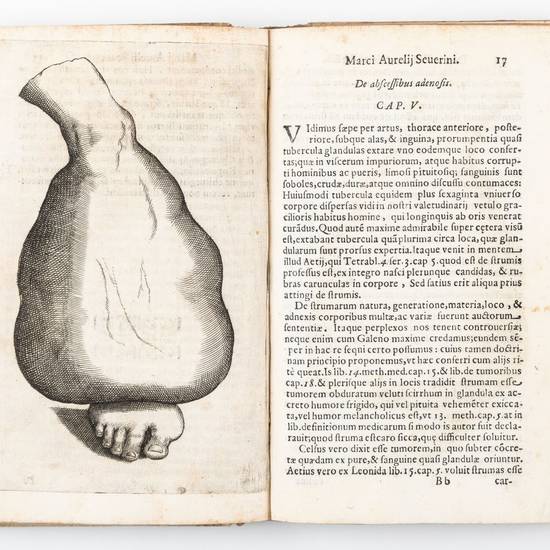4to (189x124 mm). Collation: A2, 2A-C4, 3A-Z4, AA-RR4, 4A-Z4, Aa4, 5A-G4, [χ]4. [4], 24, 48, 52, 28, 48, 144, 192, [64] pages. complete. In this copy, the first quire A2 is inserted between fol. 2A1 (title-page) and fol. 2A2 (pages 3 and 4). Engraved title-page, counted in the pagination. Woodcut initials and tailpieces. Twelve full-page engravings in the text. One full-page engraving hors text (included neither in the foliation nor pagination). Contemporary vellum over pasteboards; spine with inked title. Marbled pastedowns. Marbled edges. A good copy, some leaves uniformly browned, some foxing and staining, a tear on the last leaf. Provenance: old armorial stamp on the title-page, faded.
A landmark in the history of surgery: the rare first edition of the first textbook of surgical pathology, the first book to include illustrations of lesions with the text and the earliest organized classification of tumors of the breast.
The author, Marco Aurelio Severino, despite his neglect by medical historians, was a pioneer of comparative anatomy who made major contributions to the advancement of oncology and was highly celebrated in his time.
Born at Tarsia in Calabria, he spent the most formative periods of his life in Naples, where he carried out his studies in medicine and began teaching, before obtaining first the chair of surgery and anatomy at the University, then the post of first surgeon at the Ospedale degli Incurabili. In Naples he met and began working with Tommaso Campanella (1568-1639), whom he regarded as a teacher and from whom he took a keen interest in the natural philosophy of Bernardino Telesio (1509-1588).
In addition to his influential research and practice in the fields of medicine, anatomy, and animal physiology – and despite threats to his career by the Inquisition, who objected to his allegedly unorthodox beliefs, and others who took issue with his supposedly ‘cruel' method of healing patients – Severino forged important international connections with the European intellectual milieu. These relations are well documented by a rich correspondence with figures of international renown and reflect Severino's eminence and reputation. Among his distinguished correspondents – which include Cassiano dal Pozzo, who assisted Severino in finding skilled illustrators for scientific drawings; John Houghton, who fostered the support of Harvey's theories; and Johann Georg Volkamer, who became his agent in Nuremberg – Severino's relationship with William Harvey (1578-1657) is especially noteworthy. The two physicians met in Naples in 1636 and before his return to England Harvey gave Severino the only known presentation copy of his De motu cordis, now kept at the Houghton Library at Harvard University. The friendship, which peaked in 1645 when Severino dedicated his Phoca illustrates to Harvey, was interrupted by the English Civil War.
Severino and Harvey represented two poles in an international network of medical intelligence, they both emphasized the importance of comparative anatomy and of vivisection to the advancement of medicine, and their writings can be read as complementary to one another. Unfortunately, if Harvey's contributions are properly valued and widely acknowledged, Severino's full significance remains underrecognized, though studies of his manuscripts – now preserved at the Lancisiana Library – continue to offer scholars much stimulating material for reflection and discussion.
The copy offered here is of great bibliographical importance owing to its high degree of completeness. In fact, two different issues of the De recondita abscessuum natura are known. One, represented by the copy offered here, is complete with 192 pages, containing the Paedarthrtocace, idest de ossis circa articulum inflammatione (fols. 4A-Z4, Aa4), the four unnumbered pages of Severino's dedicatory epistle to Ferdinando Enriquez de Ribera and that addressed by Giovanni Battista Ferrario to the author himself (fols. A2) and the 56 pages including the Indice (fols. 5A-G4), and preceding the 8-page Errata (fol. χ4). The other recorded issue does not contain any of the aforementioned quires. It is not possible to establish any priority between the two issues, owing to the fact that an identical list of errata appears at the end of each, noting the errors and misprints discovered both in De recondita abscessuum natura and in the additional quires. The present copy, in this issue, is of exceeding rarity: we could trace only the Norman copy.
Garrison-Morton 2273; Krivatsy 11055; Norman 1932; C.B. Smith – C. Webster. “Harvey and M.A. Severino: A Neglected Medical Relationship”, Bulletin of the History of Medicine 45 (1971), pp. 49-75; M. Conforti, M. “Surgery, Medicine and Natural Philosophy in the library of Marco Aurelio Severino (1580-1656)”, Bruniana & Campanelliana, 10 (2004), pp. 283-298.
[10957]

